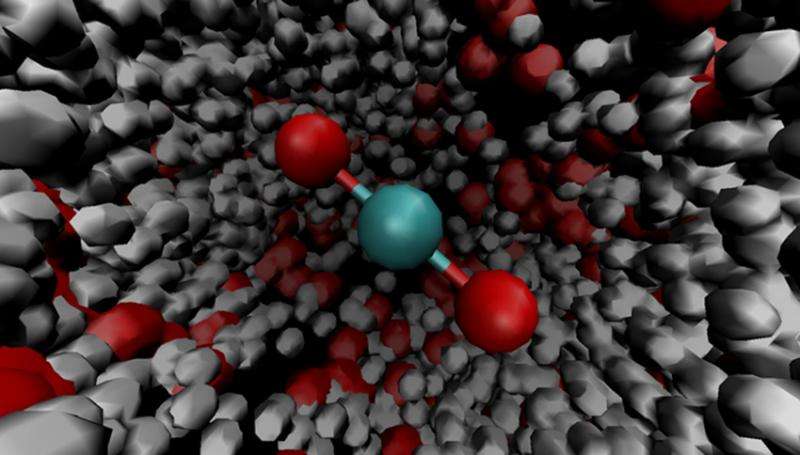Spectroscopy combined with theory and computation determines the interaction between carbon dioxide and water

In people, phytoplankton, and in fact in all living organisms, water's pH – acidic, basic, or neutral – has a profound effect. Water often becomes acidic because of contacting gaseous carbon dioxide in the atmosphere. When the carbon dioxide dissolves in the water, it forms carbonic acid. DOE Scientists characterized the structure of carbon dioxide in water. They found that the dissolved carbon dioxide bonds only very weakly to the surrounding water, but creates a cylindrical cavity in the liquid.
The interaction of carbon dioxide and water is one of the most important reactions in all of science, given that it explains the natural acidity of water and all accompanying reactions. Identifying the structure of dissolved carbon dioxide provides the starting point for all research that attempts to address this all-important reaction.
Water is vital for all living organisms; gaining a better understanding of the chemistry of water is one of the most important scientific goals. One of the qualities of water that has the largest effect on living organisms is pH. Carbonic acid (H2CO3) plays a central role in the acidity of aqueous systems because it is the most common environmental source of protons. When carbon dioxide dissolves in water, carbonic acid forms, which has a very short lifetime - typically around 30 picoseconds - before dissociating into protons and bicarbonate ions. To understand how this reaction occurs, it is crucial to fully characterize each of the species involved in the reaction, including aqueous carbon dioxide and aqueous carbonic acid. Previously, these researchers at the Lawrence Berkeley National Laboratory (LBNL) and the University of California Berkeley determined the structure of solvated carbonic acid. Following that discovery, they set their sights on the structure of solvated carbon dioxide itself, with the goal being to characterize both the "starting" and "ending" species of the reaction.
To accomplish this feat, a unique liquid microjet injector system was used for X-ray absorption spectroscopy (XAS) at the Advanced Light Source (ALS) at LBNL. The acquired XAS spectrum was then combined with molecular dynamics simulations and theoretical calculations performed at the Molecular Foundry and the National Energy Research Scientific Computing Center (NERSC). The amalgamation of these techniques provided a fully characterized structure, one in which the dissolved carbon dioxide acts as a hydrophobe, having formed only very weak hydrogen bonds to the surrounding water molecules. The result of such interactions is the formation of a cylindrical cavity in the liquid water, setting the stage for the subsequent proton transfer chemistry.
The results of this study will serve as the foundation for future research into this crucial chemical reaction.
More information: "The hydration structure of dissolved carbon dioxide from X-ray absorption spectroscopy." Chemical Physics Letters 633, 214-217 (2015). DOI: 10.1016/j.cplett.2015.05.039
"The hydration structure of aqueous carbonic acid from X-ray absorption spectroscopy." Chemical Physics Letters 614, 282-286 (2014). DOI: 10.1016/j.cplett.2014.09.052
Provided by US Department of Energy





















